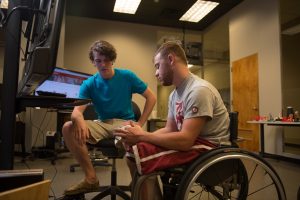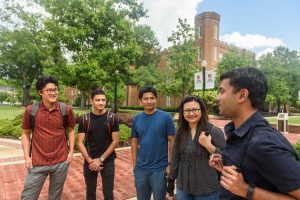
Faculty, staff and students recently heard a presentation of findings from a San Jose, California-based firm following completion of its external review of UA’s diversity efforts.
Dr. Rona Halualani, managing principal and co-founder of Halualani & Associates, presented the findings of UA’s structure, reporting channels, programs, efforts and curriculum as they relate to diversity, equity and inclusion.
This Diversity Mapping Study was a yearlong effort commissioned by UA President Stuart R. Bell and Dr. Kevin Whitaker, UA provost and executive vice president.
Halualani said her firm had mapped diversity efforts of about 48 institutions over the last 10 years, as campuses are working more diligently on issues related to diversity and inclusion.
“We are looking at your institution’s habits, activities and actions with regard to diversity, inclusion and equity. It is a baseline. Think of it as a ‘before’ picture.”
In the study, the researchers defined diversity to include areas related to gender, socioeconomic class, political perspective, age, race, ethnicity, religion, sexual orientation, disability, regional origin, nationality, occupation and language, among others.
The firm ranks the institutions it maps as either first, second, third or fourth-order campuses in regard to the impact of diversity efforts with the low end of the scale having the least impactful efforts.
“I have yet to see a fourth-order campus,” Halualani said when discussing the findings with UA’s Diversity and Inclusion Strategic Planning Subcommittee. “We located you solidly in second order, and you are pivoting toward the third order.”
FINDINGS

In its findings, the firm documented 1,695 individual diversity efforts by UA that occurred between 2011-2016.
“We did note that all divisions were on-deck. There are 10 main divisions on your campus, and each of them is participating in some way in diversity, equity and inclusion – some more than others,” Halualani said.
The divisions of Student Life, Academic Affairs and Community Affairs were leading the way, she noted.
However, quantity of efforts is not enough, Halualani said.
“It’s not really a numbers game,” she said.
The larger issue is direction and impact, the report indicated.
“There is no strategic framing aligning those efforts. We could not tell where the priorities were.”
She urged UA to be more deliberate about identifying its desired outcomes and to better prioritize its efforts to increase their impact.
“I’m not sure everyone knows if what you’re doing is moving the dial the way you want it to.”

Rather than having efforts driven by individual units, Halualani encouraged campus to have its efforts more strategically implemented and have its events, for example, tied to a student learning objective.
She urged campus to increase efforts to recruit and retain diverse faculty, staff and students.
From a curriculum standpoint, Halualani’s firm identified “many intellectually and perspectivally rich academic course offerings created by talented faculty members at UA.” In its undergraduate curricula, 83 percent (902) of UA’s diversity-related courses in the last two years were offered as opposed to just being “on the books.”
“This is the highest percentage of offered diversity-related courses that we have ever found in any diversity mapping that we have conducted,” the report states.
RECOMMENDATIONS
However, Halualani said courses needed to offer more engagements in terms of evaluation and critique of power differences, social agency and action and innovative problem solving. The report urged faculty members to have a “thoughtful conversation” about how diversity is discussed, theorized, approached and interrogated across all course levels at UA.
“The key question is how, at The University of Alabama, do you make sure every student who graduates from here is exposed to meaningful curricula or content or perspectives about diversity and inclusion?”
In summary, the firm identified nine areas for UA to take action on in the next five years:
- Create its next iteration of a universitywide diversity strategic plan
- Build out its diversity infrastructure
- Continue work on diverse undergraduate student recruitment
- Continue work on diverse graduate student recruitment
- Continue work on student retention and graduation for diverse groups
- Continue work on diverse faculty recruitment and retention
- Continue work on diverse staff recruitment and retention
- Continue work on diversity-related professional development for employees
- Design intentional diversity-centered undergraduate, graduate and Core Curriculum/General Education curricula.
NEXT STEPS
Following Halualani’s presentation, Dr. Christine Taylor, UA vice president of diversity, equity and inclusion, announced plans for campus to develop a diversity and inclusion strategic plan by June 2018.
“We want to create a campus culture in which our faculty, staff and students have that level of cultural competency that allows them to be more competitive in what we know to be an increasingly diverse and global society,” Taylor said. “That is our end goal.”

Taylor said UA deans are being asked to nominate representatives to serve on an Academic Diversity Council to work collaboratively on matters of diversity and inclusion. A series of listening sessions will be held, with announcements about the sessions occurring later this week, to enable groups of faculty, staff and students to have conversations regarding diversity, equity and inclusion.
By January, Taylor said UA plans to identify the team who will help develop a diversity strategic plan.
Taylor lauded the firm’s efforts.
“This is an enormous amount of data,” Taylor said. She committed that campus would be “laser focused” in its next steps.
“You can’t do everything well at the same time. The work we have to do here is not just for our students,” Taylor said. “It’s for our faculty; it is for our staff.”
She said her goal is for issues related to diversity and inclusion to become “standard operating procedures. It’s who we become, and I look forward to co-laboring with you.”
The 35-page report is posted on the Office for Academic Affairs website at https://provost.ua.edu/diversity/.
